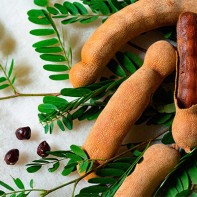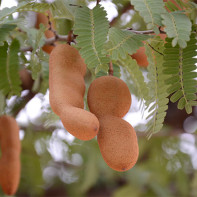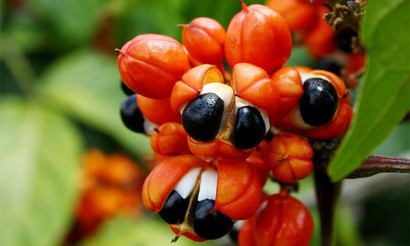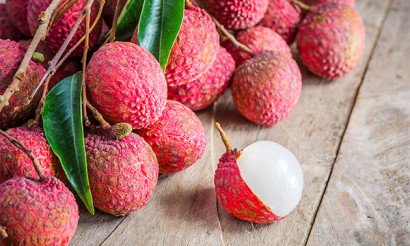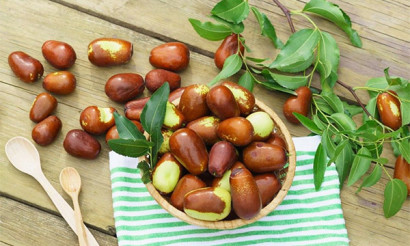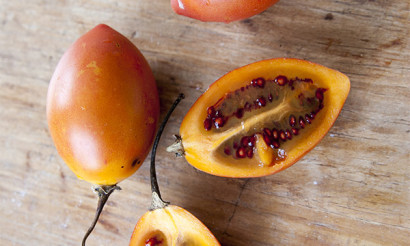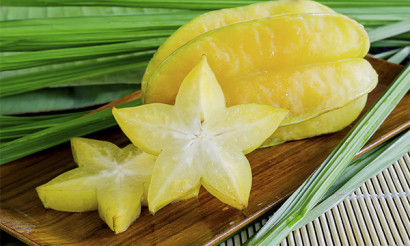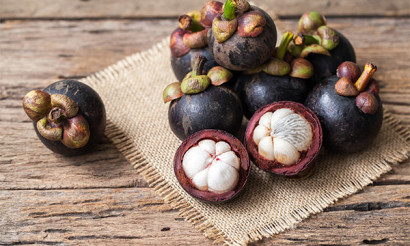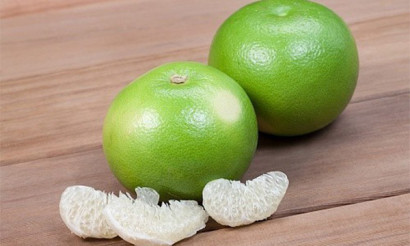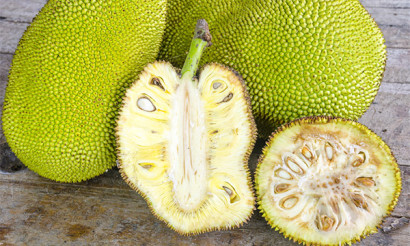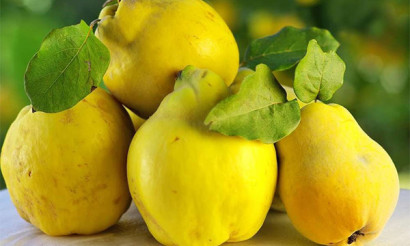Tamarind: Health Benefits
They say that in life you need to try everything. Fans of fine cuisine understand this expression in the truest sense of the word. Tamarind fruits are a common food for the peoples of Africa and Asia, but for Europeans this product is still a culinary exotic.
- What is tamarind
- What does it look like
- Where grows
- Composition and calorie content
- Useful properties of tamarind
- General benefit
- For women
- For men
- During pregnancy
- When breastfeeding
- For kids
- When losing weight
- Why tamarind paste is useful
- Tamarind in cosmetology
- Harm and contraindications
- How to choose and store
- How to eat tamarind
- Cooking use
- Sweet and sour fresh gravy
- Tonic drink
- Shrimp with tamarind sauce
- Homemade Worcester sauce
- Spicy pork ribs soup
- Chicken kebab
- Vegetarian pilaf with tamarind
- Chinese peanut sauce
- Interesting Tamarind Facts
What is tamarind
Tamarind is a tree that grows in the tropical zone of the planet. In the botanical catalog, it is called the Indian date or Indian tamarind. The plant belongs to the legume family and is the only representative of its species.
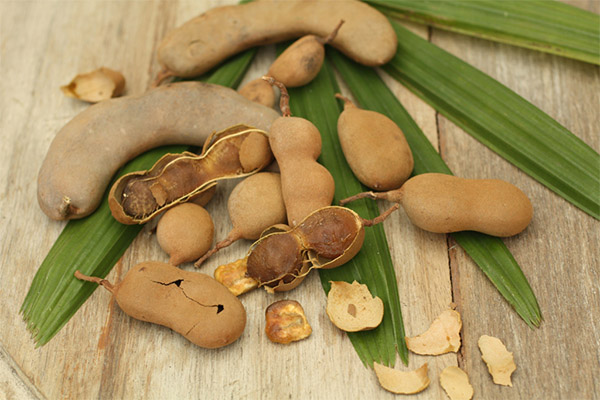
What does it look like
Tamarind is an evergreen tree that grows up to 20 m. The wood of the plant looks unusual: the inside of the trunk is folded with a solid dark red core, and the soft sapwood is painted in light yellow.
Small oval leaves are green and moderately green in color, leaf plates are thin and moderately hard. On each branch there are from 10 to 40 leaves. The arrangement of leaves is the same as that of fern or acacia.
Once a year, tamarind is densely covered with lush inflorescences. The flowers have an unusual and beautiful shape. Oblong, pointed petals are collected in a corolla, inside of which there are long, elaborately curved stamens and pistils. The color of the petals is white, pale pink and reddish, and the color of the lower and upper petals may vary.
The fruits of tamarind are a pod (bean). The length of the pod is 18–22 cm, and the thickness is 2–3 cm. Inside the hard peel are seeds surrounded by a dense, “fleshy” pericarp, which in appearance and texture resembles the date pulp. The seeds of the plant are smooth, large, have an angular-rounded shape. The shape of the bones resembles pebbles or rounded crystals.
Where grows
The homeland of the tree is the tropics of East Africa and the island of Madagascar, where tamarind grows in deciduous dry forests. Even before our era, travelers took away seeds and spread plant species far beyond the natural range. Now tamarind is growing not only on the African continent, but also in the tropical regions of Asia and on the islands of Oceania.
Already in the XVI century, the tree was introduced into Central and South America, the plant perfectly took root on local soils. The species is cultivated as a decorative and agricultural crop.
Composition and calorie content
100 g of raw tamarind contains 239 kcal. The composition of the product includes:
- vegetable proteins - 2.8 g;
- carbohydrates - 57.4 g;
- vegetable fats - 0.6 g;
- water - 30–31 g;
- fiber - 5.1 g;
- ash substances - 2.7 g.
- The energy value of 100 g of fruit is 1000 kJ.
The pulp of raw tamarind contains a large amount of vitamin A, beta-carotene, all types of B vitamins (folates, pyridoxine, pantothenic acid, choline, thiamine and riboflavin). The product has a lot of vitamin C (ascorbic acid), E, PP, K.
Tamarind contains macro and macro elements. There is a lot of potassium, calcium, magnesium, sulfur, phosphorus, sodium. The product is rich in iron, zinc, copper and selenium. Tamarind has complex amino acids necessary for metabolic processes - lysine, tryptophan, methionine. The pulp contains fatty acids - stearic, myristic, oleic (omega-9), linoleic and palmitic, as well as omega-6 groups. Tamarind is rich in sugars (di- and monosaccharides) and pectin.
Useful properties of tamarind
General benefit
The high content of vitamins and a variety of trace elements make tamarind a useful and nutritious product. It has a healing effect. We list the important beneficial properties of the plant.
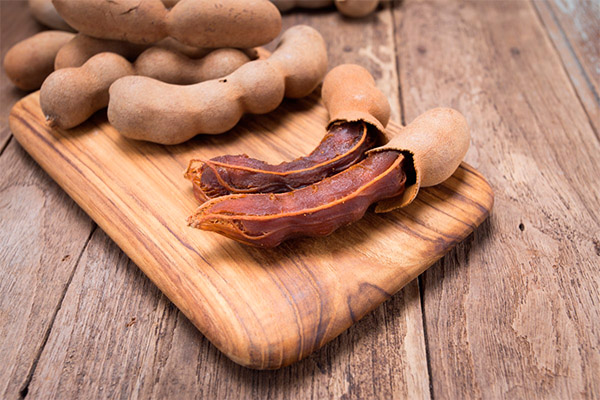
- The product contains organic acids, plant fibers and oils, therefore, improves digestion and contributes to the normal functioning of the gastrointestinal tract.
- Fresh tamarind leaves are used to treat skin rashes, have anti-inflammatory effects, and reduce irritation and itching.
- Infusions of fruits, bark and leaves have a soothing and relaxing effect.
- Tamarind is able to reduce the amount of acid in the stomach, which is important for healing ulcers, treating colitis, bacterial and non-bacterial inflammatory processes.
- The pulp of the fruit has antiseptic and antibacterial properties.
- The product can restore the hormonal background of the body and the functions of the reproductive system.
- The substances that make up the fruit are antioxidants and bind free radicals that trigger the formation of tumors.
- The presence in the fruits of potassium, selenium, sodium contributes to the improvement of the heart and circulatory system.
- The product is useful for patients with anemia, as it contains a large amount of iron.
- Fruits contain vitamins that are important for maintaining immunity.
- The antioxidants that tamarind is rich in contribute to cell renewal and slow down the aging process.
- The product reduces the level of "bad" cholesterol and prevents many diseases of the cardiovascular system.
- Tamarind is useful for people suffering from hypertension.
- Residents of the subtropics are well aware of the effect of tamarind on digestion. People who include the product in their diet notice that this fruit improves their appetite.
According to Ayurveda (Indian traditional medicine), tamarind is effective in treating diarrhea. Healers believe that with diarrhea, the intestines are quickly cleansed of toxic, pathogenic and irritating substances, after which the body will start recovery processes.
According to traditional recipes of Asian doctors, decoctions for treating malaria are prepared from bark and leaves. The drink helps in the treatment of infectious diseases of tropical countries and nervous fever.
For women
Tamarind and dishes with the addition of this fruit are useful for women suffering from hormonal disruptions. It can be eaten, taken in the form of infusions and decoctions for female diseases, accompanied by inflammatory processes.
This plant belongs to the strong aphrodisiacs that act specifically on women. The product increases the sensitivity and sexuality of the fair sex.
For men
The product has a healing effect on any foci of inflammation, so it is good to include it in the diet for acute inflammation of the prostate. Men can eat tamarind for infectious diseases, to increase immunity and maintain vitality.
During pregnancy
There is no unequivocal opinion whether tamarind fruits should be included in the diet of pregnant women. Some sources claim that the expectant mother should completely exclude such products from her menu. Other authors believe that the fruit can be eaten, but not often and in small quantities.
When breastfeeding
Public sources do not contain any information on the harm of tamarind to nursing mothers. Most likely, such studies have not been conducted, so when breastfeeding, it is better to exclude the product from the menu. In any case, during pregnancy, and when breastfeeding, you should consult a gynecologist and a children's doctor.
For kids
Traditional healers recommend taking a decoction of tamarind to expel worms, including in children. The same drink has a laxative and calming effect. If the mother has doubts about the use of the plant for medicinal purposes, it is better to consult a pediatrician. The doctor will give recommendations on how old the child can be treated with such means and how to cook them.
When losing weight
The product is able to suppress the feeling of hunger and stop the "rumbling" in the stomach that occurs when eating. Slimming people use this property of fruit and include it in their diet during the diet.
The fruits of the plant contain hydroxycitric acid, which interacts with the enzymes of the stomach, reducing the time they interact with food. This prevents excessive accumulation of nutrients.
Hydroxycitric acid obtained from fruit is a part of dietary supplements for those who want to lose weight. This substance can be found in other weight loss products.
Why tamarind paste is useful
There are two types of tamarind fruits. Fruits are distinguished by taste. Sweet and sweet and sour fruits are eaten without any processing, in kind. They have a characteristic taste, reminiscent of a mixture of good prunes and dried apricots or berry marmalade. Pasta is made from acidic varieties. Both types of fruit emit a strong, rich fruity aroma.
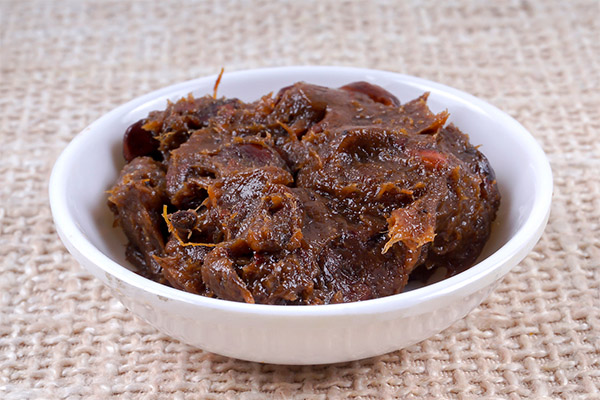
Tamarind pasta, sold in stores, is a thick, dark brown mass. A factory product differs from a homemade paste in higher density and viscosity. Homemade tamarind paste can be bought in the markets of Southeast Asia. When cooking, take into account the concentration of the product: the higher the viscosity of the mass, the smaller the amount of tamarind required by the cook. With an “overdose”, the food may turn out to be too acidic, astringent and astringent.
The paste has the same composition as the raw fruit. The product preserves all vitamins, organic acids, macro- and microelements, as well as the feedstock. Concentrated fruit mass has a bactericidal, antimicrobial, laxative effect. The product exhibits the properties of afrosidiak in the same way as the pulp of fresh fruits.
Tamarind paste is sold in glass jars, plastic containers, soft plastic packaging and is a liquid or viscous concentrate. It can be a thick, highly concentrated juice, ready to drink.
Tamarind in cosmetology
In China, Thailand and other Asian countries, tamarind is widely used in beauty salons. Infusions, decoctions and compresses of fresh leaves treat acne and other skin diseases. Masks and bathtubs are made from plant materials. The pulp of the fruit is used for compresses and wraps.
Concentrates and extracts from the leaves and fruits of the tree are among dozens of cosmetic products manufactured in the factory. Components of plant materials - an important ingredient in lotions, brightening creams and masks. Tamarind is found in gels, tonics, cleansing scrubs. Cosmetics have anti-aging, bactericidal, antimicrobial, soothing effects.
Pharmacological enterprises and cosmetics manufacturers use not only leaves and pulp, but also plant seeds as raw materials. They are pulverized to a dusty state, extracts are made and added to creams for wrinkles, products for the care of aging and dry skin. With the regular use of funds, the skin is updated, the processes of cell regeneration and rejuvenation are launched.
The active ingredient of plant materials is xyloglucan. This organic compound binds water molecules more actively than hyaluronic acid. As a result, the moisture and freshness of the skin is preserved even in dry air, which is especially important for aging and aging skin.
Whitening properties allow you to get rid of age-related age spots. Creams, including plant extract, are used to protect against solar ultraviolet radiation. The antioxidants found in tamarind seeds help to maintain and restore collagen in the skin.
Tamarind (amber) oil, which is also used in cosmetology and medicine, is produced from the seeds of the plant in a artisanal and factory way. The product is obtained by direct pressing, high-quality raw materials do not contain other vegetable oils, extraneous additives and dyes.
Tamarind oil is added to face and hair masks or simply rubbed into the scalp.With regular use, the hair becomes shiny, thick and smooth. The itching stops, the skin is moisturized, and the hair cuticles are restored. Oil destroys fungal infection and skin parasites, therefore it is used for dermatological diseases.
Harm and contraindications
Tamarind fruits should not be eaten by people who are diagnosed with a stomach ulcer and duodenal ulcer. The fruit has a laxative effect, which should be remembered with a tendency to diarrhea. The product is excluded from the diet if a person is undergoing treatment with drugs that thin the blood, since the combination of this group of medicines with an exotic fruit can lead to internal bleeding.
Diabetics should consult with their doctor, as the pulp of the plant contains sugar. If an allergic reaction occurs, the product is completely excluded from the diet. The fruit is used with caution and in small portions if there are diseases of the kidneys and liver. It is prohibited in infectious diseases accompanied by diarrhea - dysentery and salmonellosis.
You can not eat unripe fruits and use their pulp for cosmetic purposes. Green beans contain a large amount of tannins and are bitter even after prolonged heat treatment.
How to choose and store
Fresh Indian fruits can be bought in tropical countries where tamarind is grown. In Europe and Russia, this fruit is sold very rarely. When choosing a product, pay attention to the condition of the peel of the fetus. The peel of a quality fruit is firm, even, with a uniform color.

A sign of fruit damage is a wrinkled, soft peel. If there are injuries, cracks, soft spots on the pod, it can be assumed that rot has penetrated inside the fruit. Fresh, high-quality fruit after cleaning spreads a strong fruity aroma.
Unpeeled pods are stored for 5 to 7 days; the lower refrigerator box is used as a storage place. If you keep the fruits in the room, they will remain fresh for no more than 1-2 days. Dried tamarind loses a large amount of water, and the sugar contained in the fruit is a preservative. Therefore, the shelf life of dried fruits and pressed pulp concentrate is 1.5–2 years.
How to eat tamarind
The pod is cut with a sharp knife in length, along the fruit, to reveal all the flesh. This is not difficult to do, as the skin of the fruit is thin and soft enough. Having made an incision, they take the pod in their hands and break it in half with a light effort. After this, the fruit pulp is removed and the seeds are extracted. Filamentous fibers that are not suitable for food are also removed. Tamarind seeds are not eaten; they can be thrown away.
The fruit is good to eat in the morning, before breakfast or instead. This product can replace dessert during lunch and afternoon snack.
Cooking use
Tamarind fruits are suitable for making juices, cooling and tonic tea, invigorating drinks. The fruit is used as a confectionery additive in pastries, cakes and desserts. Jellies and jams, preserves and marmalades are prepared from this product, since pectin is a natural thickener. Tamarind softens the meat and gives it an exotic, spicy taste. In Asian cuisine, there are many recipes for hot, sour and sweet marinades, sauces, side dishes that are served with sushi, rolls, dishes from any meat, poultry and fish.
Aromatic water is often prepared for spicy dishes, in which tamarind is added. Such a drink softens and complements the taste of oriental seasonings.
Sweet and sour fresh gravy
To prepare the sauce you need:
- the fruits of sweet and sour tamarind;
- dates;
- Red pepper;
- garlic;
- ginger.
Process:
- 3-4 tamarind pods are peeled, pulp is removed and seeds are removed.Paste the pasta with warm boiled water and leave for 20-30 minutes, after which the water is drained.
- Dates cut, remove the seeds and remove the hard skin from the fruit. The pulp is cut into small pieces.
- The ingredients are placed in a small pan, add a pinch of red hot pepper and a small piece of ginger root, grated on a fine grater. One clove of garlic is peeled, pressed through a press (garlic squeezer) and also placed in a container.
- Whip the components of the gravy with a fork or whisk. Add 150 ml of water, put the saucepan on a fire, bring to a boil and turn off the stove. Gravy is languished under the lid for 5-8 minutes and removed from the stove.
Tonic drink
To make a drink you will need:
- a glass of cane brown sugar;
- 4 star anise star (can be replaced with the same amount of anise);
- a glass of liquid tamarind paste;
- 3 cinnamon sticks;
- 4 cups pineapple juice;
- glass of water.
Process:
- Sugar is bred in water and boiled syrup. A couple of minutes before the end of cooking add star anise. The finished syrup is removed from the stove, cooled and poured into a large container (in a jar or pan).
- Tamarind paste is placed in the syrup and the whole pineapple juice is poured. The ingredients are mixed. Drink can be served at the table.
According to this recipe, a tonic drink is prepared in all countries of southeast Asia. In the Vietnamese version of the recipe, chopped roasted peanuts and a pinch of salt are added to the drink.
Shrimp with tamarind sauce
To prepare two servings of dishes take:
- 300 g large shrimp;
- 2–2.5 tablespoons of tamarind paste (without top);
- 2 medium cloves of garlic;
- chilli;
- a small twig of cilantro.
Process:
- Boil the shrimp, peel off the shells and fry in sunflower oil for no more than 2-3 minutes. You can take olive or mustard oil.
- Peppers are peeled and chopped with a blender along with garlic and cilantro.
- The resulting mass is put in a metal saucepan, add tamarind paste, a teaspoon of granulated sugar, pour the ingredients with a glass of water and mix until smooth. The container is placed on the stove and brought to a boil while stirring.
- The sauce is poured into a pan where the shrimps are fried, close the container with a lid and stew the dish for 3 minutes. Then they lay out the food on portioned plates and serve on the table.
Homemade Worcester sauce
This famous sauce was “invented” in 19th century England. The product is good for hot appetizers, grilled meats and stewed vegetables. Sauce on a massive scale is produced at the enterprises of the food industry, but with the modern availability of products and seasonings it can be prepared in the home kitchen. The chef will need:
- 1 medium onion head;
- 2 cloves of garlic;
- 25 g rhizomes of fresh ginger;
- 2 small anchovies;
- 2-3 peas of black pepper;
- 3 tablespoons of dry mustard;
- 0.5 tbsp curry, ground red pepper, sugar;
- 2 cinnamon sticks;
- 3-4 pieces of dry clove seeds;
- 2 teaspoons of cardamom;
- 30 ml of table vinegar;
- 0.5 tsp tamarind paste;
- a glass of soy sauce;
- 100 ml of water.
Process:
- Onion, garlic and ginger root are cut into small pieces and put in a bowl. Mustard powder, red pepper, cardamom, cinnamon and black pepper are added. The components are mixed and transferred to a three-layer gauze bag.
- The bag is tied in a knot and placed in a pan. Sugar is poured on top and tamarind pulp is put, table vinegar and soy sauce are added. The pan is placed on the stove, heated and boiled for 40 minutes over low heat.
- Sliced anchovies, curry, water and salt are combined in a separate cup, the components are mixed and the mixture is added to the pan.
- In conclusion, the sauce is removed from the stove and poured into a glass jar of the desired volume (together with a gauze bag).The container is closed with a sealed lid and refrigerated.
- The vessel is opened every other day, a bag of spices is pulled out and squeezed into a liquid, and the jar is closed again. After 2 weeks, the bag is thrown away.
- The sauce is ready, it is bottled and refrigerated. Shake the liquid before use.
Spicy pork ribs soup
This first course is cooked without potatoes. For cooking you will need:
- medium sized onion;
- 5 cloves of garlic;
- ripe red tomato;
- a third of a glass of olive oil;
- half a glass of fish sauce;
- 1 white radish;
- 2.5 tablespoons of tamarind paste;
- 0.6 cups of water;
- 2-3 branches of spinach;
- salt.
Process:
- Onions are chopped into cubes. Garlic is ground on a fine grater. These ingredients are fried in a deep frying pan, in vegetable oil, until golden brown (3-4 minutes).
- Pork ribs thoroughly washed. Peel the radish and cut into large cubes.
- The meat and chopped vegetable are placed in a pan (for onions and garlic), topped with fish sauce. The contents of the container are mixed, the pan is tightly closed with a lid, the workpiece is brought to a boil and stewed for 10-12 minutes.
- Then they pour water so that the vegetables and meat are almost completely covered with broth. The soup is boiled for 10 minutes, periodically removing the foam.
- Then put tamarind paste and salt, close the pan with a lid and continue cooking until the meat is ready (30–35 minutes).
- Then add the tomato, sliced in rings, and finely chopped spinach. Stand the soup on low heat for another 5-6 minutes. The dish is ready.
Chicken kebab
This is a delicious and original dish for a festive picnic in the fresh air. For cooking, you need the following products:
- 0.6 kg of chicken or breast;
- medium sized onion;
- 2 cloves of garlic;
- 1 hot green pepper;
- half a teaspoon of ground cumin;
- a glass of tamarind juice (pasta diluted in water to taste);
- 150 g of green onion feathers.
Process:
- First, prepare the vegetables. Garlic and onion are peeled and finely chopped on the board. The pepper is cut, cleaned from seeds and cut into small pieces.
- Put onion, pepper and garlic in a pan with preheated vegetable oil and sprinkle caraway seeds. The components of the mixture are mixed and fried until the onions become soft.
- Tamarind juice is poured into the fried vegetables and the contents of the pan are brought to a boil. Then the temperature of the stove is reduced to a minimum and the sauce is cooked for 5-6 minutes.
- The pan is removed from the stove and its contents are mixed with a blender to grind the vegetables to a homogeneous mass. Pour the gravy into a stewpan and start cooking meat.
- Chicken breasts (or fillets) are cut into pieces and strung on pre-prepared wooden skewers. The meat is greased with olive oil, salted and placed on the grill. Kebabs are fried until light crust, 6-7 minutes on each side. In the process of frying, pieces are greased with sauce and turn over until the meat is cooked. Before serving, the kebab is placed on a large dish and sprinkled with green onions. The remaining sauce is served in a saucepan.
Vegetarian pilaf with tamarind
Pilaf is quickly cooked and has an unusual aroma, and the sharp sour taste of the main ingredient - rice - will pleasantly surprise fans of vegetarian cuisine. The cook will need:
- 300 g steamed long-grain rice;
- 2 tablespoons of thick tamarind paste
- half-glasses of olive oil;
- 1 medium onion;
- dried chili;
- 6 seeds of dried cloves;
- half-glasses of coconut flakes.
Process:
- Rice is washed, put in a wide pan and pour water (0.6 l). Turn on the stove and boil the rice groats until cooked.
- Coconut flakes are lightly fried in a small frying pan until it becomes a golden hue, and pour the product into a bowl. Put the frying pan on the fire again, fry the onion in olive oil, adding chopped chili, cloves and salt to it.
- Tamarind paste is added to the container.After 5-7 minutes, put the cooked rice and mix everything. The dish is ready. Pilaf is served in portioned bowls or plates and sprinkled with coconut.
Chinese peanut sauce
This product has a pungent nutty flavor that is created by a combination of peanuts and hot peppers. Ready sauce contains spicy pungency, unobtrusive sourness, it feels salt and sweetness. The sauce is prepared for boiled rice, boiled and fried meat. The chef needs the following products:
- 300 g peanuts;
- 3 cloves of garlic;
- small chili peppers;
- 2 shallots;
- a third of a glass of brown sugar;
- half a tablespoon of tamarind paste;
- ginger root;
- half a little lime;
- a third of a glass of vegetable oil;
- 400 ml of water;
- salt.
Process:
- Peanuts are peeled and peeled. If the reddish peel lags behind badly, pour a nut over with hot water. After cleaning, the nuts are poured into a blender and chopped.
- A piece of ginger is rubbed through a sieve or grater to make half a tablespoon of pasta, and put it in a cup. Lime is cut and juice is squeezed into a separate bowl. Chili pepper is crushed into small pieces. Rub garlic on a special fine grater or squeeze through a press (garlic press).
- Prepared ingredients are combined in a separate plate - garlic gruel, mashed ginger, chopped chili pepper and lime juice. Shallots are peeled and finely chopped.
- Sunflower oil is poured into a thick-walled pan and heated. Pour shallots and fry until golden brown, but no more. Then put garlic, chili, ginger and salt in a pan. The sauce is cooked for 15-20 minutes with constant stirring.
- Crushed peanuts, sugar and water are added to the ingredients and the sauce is stirred until smooth. The mass should boil well with constant stirring and not burn. Cook until the sauce thickens, this will happen in about 20 minutes. Before removing from the stove add tamarind paste.
In a freezer, nut sauce can be stored for up to six months. On the shelf of the refrigerator, the product retains taste for up to 5-6 days.
Interesting Tamarind Facts
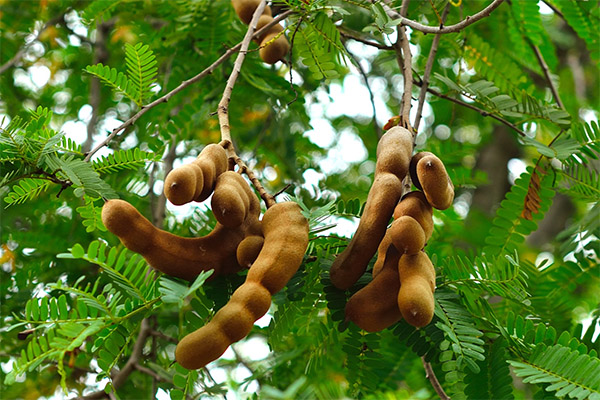
- Tamarind is grown at home as a houseplant. As planting material, seeds or cuttings are used. To accelerate germination, the hard shell of the seeds is often incised.
- The plant is often grown as a bonsai. This tree tolerates pruning and shaping of the root system. Perennial bonsai looks very beautiful, a small tree builds up a thick trunk and a lush crown.
- In Sudan, an Indian date is an invasive species. The tree feels great in the rainforest.
- In Asia, the pulp of tamarind fruits is cleaned by the statues of the gods, brass and bronze elements in temples. Acids well clean metal surfaces from grease and oxide films (patins).
- Tamarind is depicted on the arms of one of the provinces of the Kingdom of Thailand. This plant has become a symbol of the Cuban city of Santa Clara.
- From red wood of tamarind, floorboards, parquet and furniture are made. In past centuries, rods were made from flexible branches of a plant.
- The oil obtained from the fruit seeds is used to make furniture varnish. The coating is strong and durable.
- The sprawling crown of adult trees forms a dense canopy through which the rays of the hot sun do not penetrate. It is used in southern India. Trees are planted along roads to create shade.
- In some Asian countries, it is believed that tamarind bones should always be carried with you. They protect against attacks by robbers, unpleasant events and injuries, attract success and good luck.
«Important: all information on the site is provided exclusively in fact-finding purposes. Before applying any recommendations, consult with a profile specialist. Neither the editors nor the authors are liable for any possible harm caused materials. "



